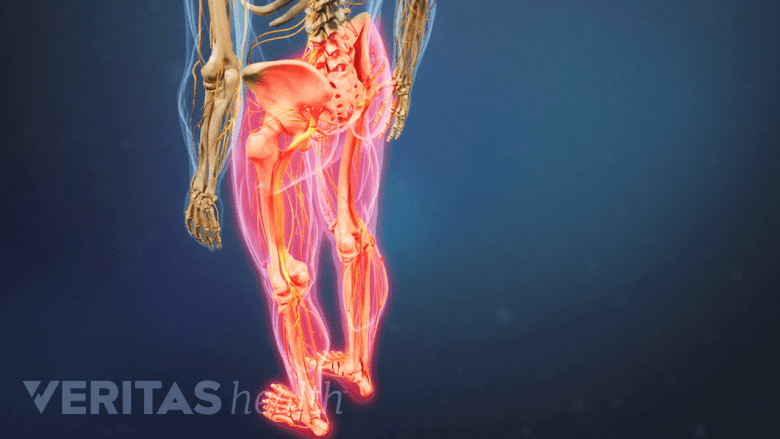The permanent implantation of a spinal cord stimulator is a minimally invasive surgery that includes a relatively simple procedure and quick recovery. Factors that affect the recovery after a permanent implant are similar to those during the trial period, including the patient's general health and how closely the care instructions are followed.
In This Article:
- Recovery After Spinal Cord Stimulator Implant Surgery
- Recovery After Spinal Cord Stimulation Trial
- Recovery After a Permanent Implant for SCS Treatment
Types of Stimulators for SCS
Spinal cord stimulators can differ based on the type and frequency of impulses generated.
Different types of stimulators are used for spinal cord stimulation (SCS) treatment. The stimulators can be broadly classified based on the1 :
- Type of impulse: Stimulators that cause paresthesia (tingling sensation) and those that are paresthesia free
- Frequency and delivery of impulse: Stimulators that generate continuous stimulation (traditional stimulators), burst stimulation, or high-frequency stimulation
- Battery type: Stimulators with chargeable batteries and non-rechargeable batteries. Chargeable stimulators have a longer battery life and charge through the patient's skin. Non-rechargeable stimulators have a shorter battery life of 4 to10 years based on the manufacturer. Both will need to be replaced at some point if they are continuously used for pain management, but the replacement is a short outpatient procedure.
Some newer technology stimulators are wireless, but the efficacy of these stimulators are not fully understood at this time.
Sedation and Surgery
The surgical steps are similar to those in the trial phase except for an additional incision that is made to house the pulse generator device under the patient's skin. Patients are either given spinal anesthesia or general anesthesia—this selection depends on the patient's condition and the surgeon's preference.
See Spinal Cord Stimulator Implantation Surgery: Step by Step
Hospital Care and Recovery After Permanent Implant for SCS
Hospital recovery after a permanent spinal cord stimulator focuses on managing pain and learning how to use the SCS device. Most implantations are still done as an outpatient procedure, but for those with other health issues, a one-night stay may be needed. Some patients may require to stay more than a day after the surgery.
Immediate care after permanent implant for SCS
After the effect of anesthesia wears off, most patients experience some degree of pain and drowsiness from the surgical procedure. Intravenous or injectable pain-relieving medication is administered in the beginning and as the severity of pain decreases, oral medication is started.
When to expect pain relief
Post-surgical pain is typically higher during the first 10 days after surgery and begins to significantly reduce after this period.2Bendel MA, D'Souza RS, North TJ, Pittelkow TP, Hagedorn JM. Skin Closure Technique and Postprocedural Pain after Spinal Cord Stimulator Implantation: A Retrospective Review. Pain Res Manag. 2021;2021:9912861. Published 2021 Jun 4. doi:10.1155/2021/9912861 The female gender is typically associated with higher post-surgical pain compared to males.2Bendel MA, D'Souza RS, North TJ, Pittelkow TP, Hagedorn JM. Skin Closure Technique and Postprocedural Pain after Spinal Cord Stimulator Implantation: A Retrospective Review. Pain Res Manag. 2021;2021:9912861. Published 2021 Jun 4. doi:10.1155/2021/9912861
The use of sutures to close the incision has been associated with slightly reduced post-surgical pain compared to staples. If sutures are used, they dissolve into the skin and don’t need an additional removal step later compared to staples. Once the incision site heals the recovery sets in, no pain is felt at the surgical site.2Bendel MA, D'Souza RS, North TJ, Pittelkow TP, Hagedorn JM. Skin Closure Technique and Postprocedural Pain after Spinal Cord Stimulator Implantation: A Retrospective Review. Pain Res Manag. 2021;2021:9912861. Published 2021 Jun 4. doi:10.1155/2021/9912861
Walking, getting out of bed, and moving after permanent implant for SCS
Walking is encouraged as early as possible. Patients work with physical and occupational therapists to learn the safest ways to walk, dress, sit, stand, and take part in other activities without putting added stress on the back. Even getting out of bed requires a special technique—known as log-rolling—to avoid twisting the spine.
In some cases, the physical therapist may advise the patient to use a walker for stability. The occupational or physical therapist also helps arrange medical equipment for later use in the person's home, if needed.
Many people find it helpful to bring sturdy slip-on shoes with them to the hospital, since surgeons and hospital staff encourage patients to get up and walk around as quickly as possible after the surgery.
Caring for the Incision
The surgical incision site needs to be cleaned daily and checked for signs of infection. It is recommeneded to strictly follow the surgeon’s instructions for at least the first two weeks post surgery. If the incision is healing well, it should be kept clean and dry. Possible signs and symptoms of infection at the incision site include an increase in redness, pain, or discharge, fever and/or chills. If one or more of these symptoms and signs develop, they must be evaluated by the surgeon immediately.
Avoiding hot baths and hot tubs for at least 4 weeks or until cleared by the physician is advisable.
Immediate Activity Restrictions After Permanent Spinal Cord Implant Surgery
Immediate activity restrictions after a permanent implant are similar to the trial phase and include avoiding full baths and showers, strenuous physical activities, and moving with caution (avoiding bending, twisting, stretching, and raising the arms above the shoulder level), which is typically continued for 6-8 weeks.
Precautions and Considerations After Permanent Spinal Cord Implant Surgery
While there are no specific permanent activity restrictions after the permanent implant, patients are advised to use caution to protect their device and prevent the leads from breaking or migrating. A few things to consider include:
- Driving. Patients are advised to turn off their stimulator when they need to drive but may keep the device on if they are a passenger.
- Radiographic imaging and scans. Some SCS devices may not be compatible with MRI scanning machines.
- Swimming and water sports. Once the sutures are healed/staples are removed patients may participate in water activities and swimming—only if the surgeon permits.
- Traveling. A spinal cord stimulator is detectable by the scanning machines at the airport. Sometimes, patients with implanted devices receive medical certificates or cards explaining the purpose of the device and authorizing its use.
- Sudden movements. The electric impulse generated in the device is fairly consistent, and patients get used to the tingling feeling over time. However, sudden movements may sometimes cause the impulses to intensify, causing momentary discomfort.
- Caring for the remote. The device's remote or controlling apparatus is used to turn the device on and off as needed. Patients must carry the remote with them when they leave the house to be able to adequately control their SCS generator while on the go.
If there are any concerns about the impulses generated from the SCS device or if the impulses become a distraction and cause significant discomfort, consulting the surgeon is recommended.
Spinal Cord Stimulator Device Care
Caring for the SCS device involves the following processes:
- Taking care of the SCS device remote—storing it in a safe place helps prevent damage
- Charging the device's battery on a timely basis—rechargeable batteries have charging instructions, which are provided in the device's manual
The surgeon initially establishes the stimulation setting on the device but if any changes are needed, patients may follow the device's instruction manual to make any necessary changes.
When to See a Doctor

Weakness or loss of strength in one or both legs or arms warrants immediate medical attention.
Regular visits may be needed on a monthly basis to check the positioning of the device and leads, and to ensure that the treatment is progressing as expected. Doctors may also check the settings of the device and make adjustments based on the patient's needs.
Immediate medical attention is needed if one or more of the following signs and symptoms occur:
- Pain, redness, bleeding, and/or discharge at the surgical site after 7 days
- Weakness or loss of strength in one or both legs or arms
- General weakness and/or headaches
- Severe neck or leg pain that starts suddenly or gradually
- Fever or loss of consciousness
These symptoms may indicate an infection or serious medical condition affecting the spinal cord, which needs prompt treatment.
See When Back Pain May Be a Medical Emergency
Complete recovery after a permanent spinal cord stimulator implant may take several weeks to months and varies from one patient to the other. Caring for the device and the body, getting help from friends and family, and consulting the treating physician if concerning symptoms arise are key to a successful recovery after surgery.
- 1
- 2 Bendel MA, D'Souza RS, North TJ, Pittelkow TP, Hagedorn JM. Skin Closure Technique and Postprocedural Pain after Spinal Cord Stimulator Implantation: A Retrospective Review. Pain Res Manag. 2021;2021:9912861. Published 2021 Jun 4. doi:10.1155/2021/9912861
Editor’s Top Picks
- Spinal Cord Stimulation for Chronic Back and Neck Pain
- Disadvantages and Risks of Spinal Cord Stimulation
- Who May Benefit from Spinal Cord Stimulation
- Spinal Cord Stimulation for Chronic Back Pain Video
- Spinal Cord Stimulator Implantation Surgery: Step by Step
- Spinal Cord Stimulation for Chronic Neck Pain Video

